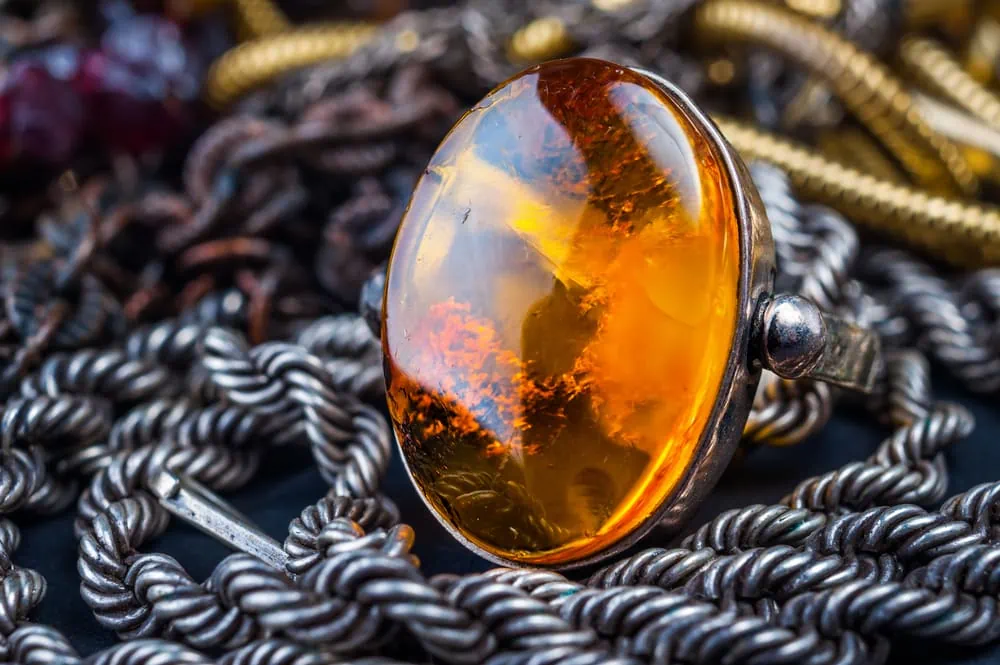Amber, often referred to as “the gold of the sea,” has captivated humans for thousands of years. This fossilized tree resin, prized for its warm hues and natural beauty, has been used in jewelry and decorative arts since prehistoric times. Amber necklaces, in particular, have stood the test of time, embodying a blend of natural allure and artistic craftsmanship that continues to enchant wearers and collectors alike.
The Origins of Amber
Amber is formed from the resin of ancient trees, primarily coniferous, that lived millions of years ago. Over time, this resin hardened and fossilized through a process of polymerization, often trapping flora, fauna, and other particles within, creating unique and fascinating inclusions.
Amber has been found in archaeological sites dating back to the Stone Age, where it was used for amulets and ornaments. Ancient civilizations, such as the Egyptians, Greeks, and Romans, highly valued amber, trading it across vast distances. Its association with the sun and its perceived protective qualities made it a treasured material for both practical and mystical purposes.
The Baltic region is the most famous source of amber, particularly the areas around the Baltic Sea, where large deposits have been mined for centuries. Other notable sources include the Dominican Republic, known for its blue amber, and regions in Myanmar and Mexico.
The Unique Properties of Amber
Amber is an organic gemstone, typically ranging in color from pale yellow to deep orange and brown. It is lightweight, has a hardness of 2-2.5 on the Mohs scale, and often emits a distinctive pine scent when rubbed or heated.
Amber comes in various colors, including the common honey and cognac shades, as well as rarer colors like green, red, blue, and black. The color can be influenced by factors such as the type of tree resin, the conditions under which it fossilized, and the presence of impurities or inclusions.
One of the most captivating features of amber is its inclusions—ancient insects, plants, and other materials trapped within the resin millions of years ago. These inclusions offer a glimpse into prehistoric ecosystems and are highly valued by collectors and scientists alike.
Crafting Amber Necklaces
Traditional methods of crafting amber jewelry involve hand-carving and polishing, often using simple tools. Modern techniques may include machine-cutting and advanced polishing methods to achieve precise shapes and high-gloss finishes.
Artisans use a variety of tools, such as saws, files, drills, and polishing wheels, to shape and refine amber pieces. Attention to detail and a steady hand are crucial in creating smooth, polished surfaces that highlight amber’s natural beauty.
The process begins with selecting high-quality raw amber, which is then cut into smaller pieces, shaped, drilled, and polished. The finished beads are strung together to create necklaces, often combined with other materials like gold, silver, or other gemstones to enhance their aesthetic appeal.
Amber in Different Cultures
In ancient Egypt, amber was used in jewelry and amulets believed to have protective powers. The Greeks and Romans admired amber for its beauty and mystical properties, incorporating it into various decorative and religious items.
Many cultures have attributed magical and healing properties to amber. In Baltic mythology, amber was believed to be the tears of the goddess Jurate, while other cultures saw it as a symbol of the sun and a source of life and energy.
Today, amber remains a popular and culturally significant material in many regions, especially in the Baltic states. It is often used in traditional jewelry and as a symbol of national heritage and natural beauty.
Fashion and Style
Throughout history, amber necklaces have been worn as status symbols and fashion statements. They adorned the necks of royalty and nobility, signifying wealth and sophistication.
Contemporary designers continue to explore amber’s potential in fashion, creating innovative and stylish pieces that appeal to modern tastes. Amber necklaces are often featured in collections that emphasize natural materials and sustainable practices.
Amber necklaces can complement a variety of outfits, from casual to formal. Pairing a simple amber pendant with everyday wear can add a touch of elegance, while a statement amber necklace can enhance an evening gown or a chic business ensemble.
The Healing and Metaphysical Properties of Amber
Amber has long been used in holistic practices for its supposed healing properties. It is believed to alleviate pain, reduce stress, and boost the immune system when worn against the skin.
In metaphysical circles, amber is considered a powerful healing stone that can absorb negative energies and promote emotional balance. It is often used in meditation and spiritual healing practices.
Many people share personal stories of how amber has positively impacted their well-being, from providing relief from chronic pain to enhancing their sense of calm and clarity.
Amber necklaces continue to captivate and inspire, thanks to their natural beauty, rich history, and timeless appeal. Whether worn for fashion, cultural significance, or personal well-being, these elegant pieces remain cherished adornments that connect us to the past while enhancing our present.
